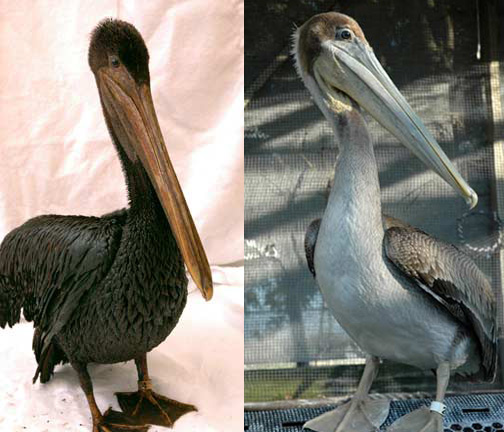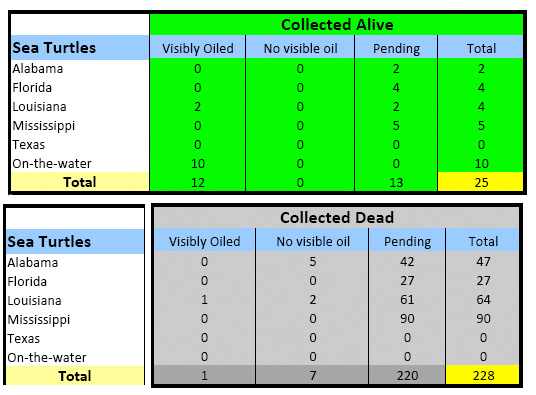
<a href="http://www.ibrrc.org/">International Bird Rescue Research Center</a>
By now, some of you have probably seen the same heartwrenching pictures of oil-slicked birds that I have. These creatures are so bogged down by brown gunk that they can barely move. To counter those images (which have been stuck on repeat in my head) I present the picture at left: the same brown pelican before and after cleaning, showing that although an oiled animal may look awful, recovery is possible. As our reporter Mac McClelland has told us (along with other sources) Audubon is on the scene in Louisiana, as is the International Bird Rescue Research Center (IBRRC) and the Delaware Tri-State Bird Rescue & Research. The agencies are working to capture, clean, and rehabilitate birds who can no longer swim or fly due to oily feathers, and many of whom are sick from ingesting the toxic crude. IBRRC has a 20-person team at the scene. Head Jay Holcomb wrote today:
“I am sure by now you have all seen the pictures of the oiled birds that were captured in Grande Isle, Louisiana. We are busy today with those birds… Please know that we are all doing well here, unhappy like you that this is happening, but we have a great master plan to offset as much damage to the birds as we can… I also want you all to understand that this entire oiled bird rehabilitation effort is being paid for by BP. This is appropriate as they are the Responsible Party for this spill.”
The process of cleaning a bird seems fairly straightforward, but laborious. First, animals must be identified, treated for immediate health concerns, tagged, and stabilized. Birds (already stressed from the oil) do not like being handled, so the cleaning process itself is stressful for them. After an initial medical examination is made, the birds are usually rehydrated manually through a rubber tube. (As a former wildlife volunteer, I can tell you that this rubber tube business usually goes smoothly: you pry open the beak and gently guide the tube down the throat into the stomach. But the birds do not like it, and when they bite, they bite hard.)
After all this, the cleaning can finally begin. Using a solution of Dawn dishwashing soap and warm water, workers put birds through a series of baths, using attachments to “aerate” the solution through the feathers. After one bath gets dirty, they move the bird to the next one and do the process again. IBRRC says that using 10 to 15 tubs is “not uncommon.” After the oil is finally off, the bird is rinsed thoroughly and put under special air-dryers. After that, it’s off to the water pools where the bird can paddle around, and experts can observe it before release.
To hear what the process is like for humans, you can read this interview with Louisiana’s Audubon director of bird conservation Melanie Driscoll. Or to see part of the process yourself, see the video below (courtesy the Miami Herald) featuring the IBRRC’s bird rehab center.














